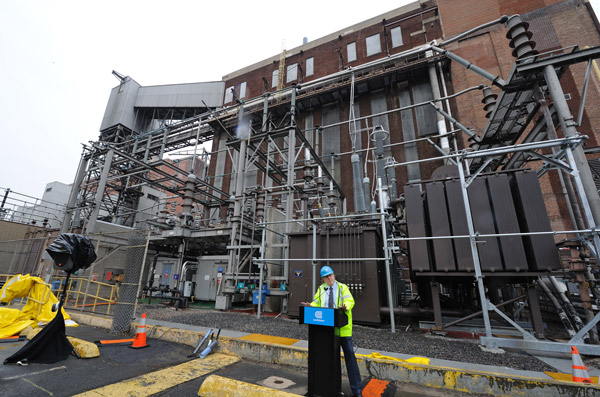
Kevin Burke, Con Edison’s C.E.O., on Tuesday, visited the 13th Street substation, which was flooded after Hurricane Sandy.
BY TERESE LOEB KREUZER | In the wake of Hurricane Sandy, Con Edison is investing $80 million into Manhattan south of Canal St. to fortify it against future storms.
The money will go for new transformers encased in protective covering, making them impervious to salt water, and for new, remote-controlled switching gear.
“We all know something’s going to happen again,” David Gmach, Con Ed’s director of public affairs, told Community Board 1’s Quality of Life Committee May 16. “There are only so many things you can do under those circumstances.”
First of all, he said, you can try to block the water while raising electrical equipment out of locations that might be flooded. In addition, you can install equipment that can withstand being in water. You can preemptively turn off the power grid so that equipment doesn’t get damaged, and you can try to minimize the number of people who lose power.
Gmach outlined Con Ed’s plans for addressing each of those possibilities.
With the exception of Battery Park City, most of which did not lose power, and the Bowling Green and Fulton St. areas, Manhattan south of 39th St. on the East Side and south of 23rd St. on the West Side lost power because of the flooding at Con Ed’s 13th St. substation, he explained. This substation services most of Lower Manhattan.
On Tues., May 28, Kevin Burke, Con Ed’s C.E.O., toured the 13th St. facility with reporters and said the utility is investing $1 billion in the entire region.
Equipment in the substation was flooded on the night of Oct. 29 and ceased to function. However, in the Bowling Green and Fulton St. areas, Con Ed personnel anticipated severe flooding and turned off electrical equipment preemptively.
“Gradually we got each of these segments back by Nov. 3,” Gmach said at the C.B. 1 meeting. “But there were still hundreds of buildings that were unable to receive power. So while the grid was reenergized in days, it took literally weeks and months of working with many of the property owners — literally building by building in some cases — to repair our equipment and to get these building owners reenergized as they repaired their equipment.”
He said that as a precaution, Con Ed had to turn off power to a larger geographic area than was necessarily flooded. The plan now is to segment the grid with isolation switches so that Con Ed can shut down discrete parts of the network.
“When water is coming in, we can preemptively take part of the area off the grid and leave the other area on and then, as the water recedes and we’re sure that the equipment is safe, we can restore power to those areas,” Gmach said.
He said that Con Ed will be installing 21 switches in Lower Manhattan at a cost of $21 million. This work will occur between now and 2016.
In addition, he said, Con Ed is developing new, submersible transformers of varying sizes.
“Before Sandy, there was no manufacturer that designed these to be submersible,” Gmach said. “We worked with a manufacturer to develop a prototype. You’re basically trying to put a box around copper. Water, copper and salt are a very bad mix.”
He said that Con Ed would spend $20 million to install 182 of these in Lower Manhattan.
For other customers, Con Ed has developed smaller, submersible transformers that will be installed under sidewalks. Though these will now have a protective casing, they have been redesigned to make them no larger than the transformers they are replacing.
“The last thing we want to do is to take out the transformers that are currently in the sidewalk and spend time digging up more of the sidewalk to put a bigger hole in the ground so we can put in bigger equipment,” said Gmach. “We have a brand new design for submersible equipment, all of it done post-Sandy, so that this equipment can go into existing structures.”
There will be 158 of these units installed in Lower Manhattan, costing $39 million. Con Ed plans to have most of this work done by the end of 2014.
Catherine McVay Hughes, Board 1’s chairperson, said she was “thrilled” by the utility’s investment Downtown, although other members expressed concerns about the coming construction.
“We are fully aware of how much construction is already going on in this neighborhood,” Gmach said. “These are construction projects. We will have to be digging up manholes in the streets in order to install some of these.”
He said that for each installation, that process could take several days including breaking up and repairing the sidewalk. “In some cases, we may have to widen an existing structure, which is a bigger job,” he noted. “I don’t want to downplay in any sense that there’s a significant amount of street work that will be going on with this.”
He said that Con Ed was not yet ready to actually start doing this work “but we’re letting everyone know what the plan is.”
































